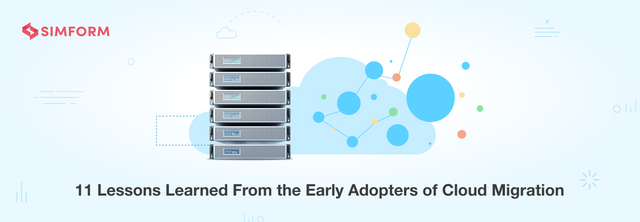11 Lessons Learned from The Early Adopters of Cloud Migration
Cloud migrations need elaborate planning and strategizing to reap the benefits of cloud-based resources. However, it is not that easy to strategize a cloud migration without enough experience in the cloud landscape. This is where you can learn from industry experts how to strategize, execute and leverage different cloud-based technologies for your migrations. Here, we have discussed 11 such lessons learned from cloud adopters and leaders for your cloud migrations.
Lesson 1: Containerization, microservices, naming conventions, and cloud migration partner
Mcdonald’s decided to take external help from the cloud engineers and consultants expert in the subject since cloud migration was an entirely new concept even for the technical teams due to the short span and its steep learning curve.
Lesson 2: Break down the goals and organize the requirements
Jack in the Box, during its cloud migration process, kept breaking down big transformation goals into smaller, more specific, and priority-based goals. It teaches us that implementing project scope in sprints is the key to infrastructure transformation.
Lesson 3: Critical monitoring and choosing the right cloud-services partner
Wyndham Hotels & Resorts figured that their cloud migration process needed critical monitoring and data assessment to handle massive data size––like 9000+ hotels across 18 brands. So naturally, this dictates that you should avoid issues that could hamper migration.
Lesson 4: Embrace re-engineering and re-architecting
Netflix’s example changes the way companies think about reengineering what’s already existing in their infrastructure. It urges adoption and appreciation of the IT infrastructure re-engineering process for a successful migration to public clouds.
Lesson 5: Taking one task at a time, dedicated team & rigorous preparation
Spotify’s case teaches us to to take one thing at a time. Their engineering team migrated 50-70 services a week that helped their stakeholders, development team, and other members keep up with the progress. It shows us how conducting multiple processes simultaneously slows down the entire migration process.
Lesson 6: Choose a cloud platform that secures reliable communication among application components.
We learned from Aldo’s case that architecture with multiple APIs fails the systems when the platform needs real-time interactions and data. Since the mobile platform of Aldo had multiple APIs, they disrupted real-time communication with multiple data sources.
Lesson 7: Customized migration approach brings better outcomes
A+E networks picked a systematic approach to migrate multiple applications. They didn’t re-architect all of the 38 apps but kept its architecture requirement-oriented. They refactored a couple of apps to a service-based architecture running on serverless technology like Amazon Aurora and DynamoDB.
Lesson 8: In-depth estimation is a game-changer
Coca-Cola’s journey to cloud migration started from the initial estimation that had pushed them into complete denial. But when they consulted a technical partner and eventually did the in-depth analysis, it resulted in 40% operational saving and an 80% reduction in help-desk tickets.
Lesson 9: Optimizing the usage of cloud assets and autoscaling
Pinterest had already been using AWS EC2 for quite some time then and needed a solution to reduce the reliance on resources and optimize the development. AWS EC2 charges for the instances that you use for development. With docker containerization powered by Kubernetes, the team reduced the instance hours and, in turn, made it cost-effective.
Lesson 10: Leveraging cloud-native tools and services
Symantec managed to reduce 40% of database-running costs by moving to cloud-based services from Microsoft Azure. So you could also leverage database infrastructures on the cloud-like AWS RDS, Azure Cosmos DB, and others to reduce the infrastructure overhead and optimize the operational costs.
Lesson 11: Distribution of content and autoscaling through AWS EC2 Instances
Any content-based business can leverage Amazon CloudFront to deliver different content forms at lower latency and faster transfer speeds. For example, WWF leveraged the Amazon CloudFront through PoPs(Points of Presence) for rapid content distribution.
Conclusion
Remember, cloud migration is not about being ‘reluctant.’ Instead, it’s an origin to start your journey as a more prominent platform available for the world by making it endlessly scalable.
We’ve studied the cloud migration experiences of many tech giants, and as a select partner of AWS cloud services, we’ll be delighted to assist you in transforming your cloud migration goals. So head over to our ebook for more details on the cloud migration checklist, strategies, challenges, and case studies.
Originally published at Simform: Lessons from The Early Adopters of Cloud Migration
